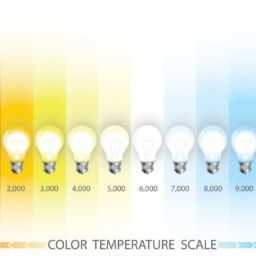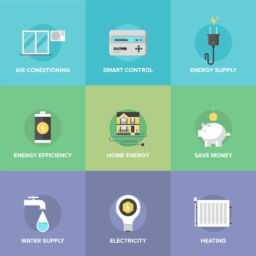Electrical earthing system and its components
Electrical earthing system and its components
electrical grounding system, The electrical grounding system is one of the important components of the electrical circuit that is used to protect people and sensitive electrical devices from electrical insulation breakdown and electrical current leakage.
The electrical grounding system is of great importance in discharging static charges. And protect people from potential shocks and electric shocks as a result of insulation breakdown or contact.
Follow this article with us to learn the importance and components of the electrical grounding system.
electrical grounding system
What is an electrical grounding system
It is the process of contacting a copper conductor between the metal objects of electrical loads, such as electric motors, transformers, main and sub panels, And between the ground electrode through which the accumulated current on the electrical load structures is delivered directly to the ground, Where its resistance is as low as one ohm only.
How to connect the electrical grounding system
The importance of electrical grounding system
All electrical networks are grounded for several reasons:
- Protect people from electric shock.
- Protect electrical appliances from possible faults.
- Reduce the possibility of fires.
- It works to discharge static charges.
- Protection of devices from sudden change in supply voltage (Voltage Surges).
The difference between the presence and absence of a grounding system
electrical hazards

electrical hazards, The dangers of electric current are among the factors that directly affect human life.
Where the electric current causes direct shock or shock when touching any part of the electrical conductors carrying the electric current.
Follow this article with us to know the causes of the dangers of electric current, And its impact on human life and the factors of different impact and degree of seriousness.
The effect of electric voltage (current) on humans
When an electric current passes through the human body, It will cause some serious accidents such as burns, wounds or death, The risk ratio depends on the high voltage difference and the intensity of the current passing through its body. Therefore, when dealing with electricity, protective equipment and caution must be worn to ensure safety to avoid the dangers of electric current.
electrical grounding system
Factors affecting the current flowing in the human body
There are several effects represented by the dangers of electric current, which are:
- Thermal effect: It is the external combustion of the human body.
- Analytical effect: Resulting from the decomposition of blood and vital fluids.
- biological effect: muscle spasms, such as the muscles of the heart and lungs, that causes tissue rupture, Disruption of breathing and blood circulation in the human body.
Factors of difference in impact and degree of severity
- The direction of the current passing through.
- The degree of intensity of the current flowing.
- Duration.
The direction of the current passing through
Electric current passes through the human body from different areas, It also comes out of other regions. Among the paths that pass through the human body are:
- hand and the other hand.
- hand and foot.
- foot and the other foot.
- Head and feet or both feet.
All of these pathways represent the dangers of electric current to the human body.
electrical grounding system
The degree of intensity of the current passing through
It is one of the factors affecting human life. It depends on the intensity of the current passing through the human body. The greater the intensity of the electric current passing through the human body, The more dangerous it becomes for him.
The effect of alternating current (AC) voltage on humans
The effect of voltage on the human body depends on the value of the current and electric voltage together. The greater the value of the current passing through and the higher the value of the electric potential, The higher the risk, and therefore the alternating current must be careful.
Electrical earthing system and its components
The effect of constant voltage (current) on humans
It is known that the battery does not affect the human body, This is because the value of the voltage between its poles is very low compared to the risks of alternating current, which has a value of up to 230V. And in some other countries it reaches 110V.
The dangers of continuous electric current passing through the human body may cause major burns and threaten his life.
human body resistance
The structure of the human body varies from person to person and from man to woman according to its resistance against the dangers of electric current. Therefore, the greater the resistance of the human body, the better and the lower the risk. But this does not mean that you do not feel the electric shock, As we said before, if the intensity of the current passing through is high, this may pose a great danger to human life.
electrical grounding system
Factors affecting the resistance of the human body
- The thickness of the skin layer.
- contact site.
- How moist the skin is.
| Electrical current in milliamperes | How dangerous is it to humans? |
| 10-0 | Not feeling the electric current |
| 50-10 | Feel a slight shiver |
| 100-50 | It cannot lift the part that is in contact with the power source |
| 150-100 | lost consciousness |
| 200-150 | lead to death |
| above 200 | body burns |
An illustrative table of how dangerous the current passing through the human body is
electrical grounding system
Duration
It is one of the most important risks that determine the severity of the shock to the human body. Thus, the time period for the current to cross the human body increases, the more it affects it negatively.
| The maximum current in the body | Duration | How dangerous is it to humans? |
| 0-0.5 | continuously | Does not affect |
| 0.5-5 | continuously | feeling light |
| 5-30 | several minutes | The power source cannot be removed |
| 50-30 | several seconds | Rapid heart rate with irregularity and fainting may occur |
| more than 100 | More than 20 milliseconds | It leads to fainting and death |
An illustrative table to determine the extent of the dangers of electric current to the human body during the period of time

Electrical earthing system and its components
Components of an electrical grounding system
- terrestrial network: A set of copper conductors are connected between the metal structures and the ground.
- Earth pit: It is the process of delivering a set of electrodes that are inserted into the ground, With the aim of good connection between the ground network and the surrounding soil.
- main ground conductor: It is the conductor that is attached to a group of electrical appliances metals to a grounding electrode.
- splicing connector: Through which all metal structures are connected to the main conductor, Then it is connected to the main ground conductor directly.
- Functional grounding: Through which the neutral point of the electric power transformers is grounded, and grounding common points of current transformers.
- Grounding for lightning protection: It works to protect the installations from the risks of fire and destruction resulting from the discharge of high current charges.
Earth resistance
It is known that the mass of the Earth has a very low resistance, But that does not mean that every place on earth has the same value of resistance, What is meant here is that each soil type has a certain value.
for example, Wet soil containing salts that have very low resistance, Compared with dry and desert land, which increases its resistance slightly.
soil quality resistance
The value of the specific resistance changes based on the quality and percentage of moisture and the amount of salts present in it. All this directly affects the connection of the electrical grounding system.
And do not forget that the grounding electrode is subject to the passage of high short-circuit currents as well, This has a negative effect on the copper conductors and the conductive electrodes in the soil if the short-circuit current through the conductors and electrodes is relatively long.
To avoid this problem, the short-circuit current per meter of electrode length should not be more than the value calculated from the following equation:
Current law of the electrical grounding circuit

The difference between the cold line (neutral) and the grounding line
Neutral: It is the line in the electrical circuit. Its function is to close the circuit in order for the natural current to pass to the source of supply.
Neutral line connection
Grounding System: It is installed on the electric load structure in order to protect the load from electrical faults, And discharge the accumulated charges on the metal structure.
If there is no ground system in the electrical network, This will adversely affect the electrical appliances.
Types of grounding systems
 electrical grounding system
electrical grounding system
types of grounding systems, In this article, we present to you the most famous types of grounding systems used to protect individuals from the risk of electric shock resulting from short insulation and its collapse.
The importance of grounding is also to prevent the danger of electrical discharge caused by lightning strikes. And protect electrical equipment equipment from changes that may occur in the feeding direction.
Follow this article with us to learn about the types of grounding systems, their advantages and how to connect them.
Types of grounding systems
- TN-type grounding system is divided into three sections:
- TN-S type grounding system.
- TN-C type grounding system.
- TN-CS type grounding system.
- IT type grounding system.
- TT type grounding system.
TN-S type earthing system
The meanings of the following symbols:
T = short for the French word Terre, It means land.
N = Neutral abbreviation. It means a straight line.
S = Isolated, It means separate.
Earthing system: TN-S is the separate system between the grounding line and the neutral line.
System installation
It contains the consumer grounding line, the external source grounding line (transformer or generator) and the neutral line, The consumer grounding line shall be separated from the transcendent line along the distance between the external source and the consumer, And they meet only at the point of grounding of the external source (transformer or generator).
TN-C . TYPE EARTHING SYSTEM
The following symbols mean:
T = short for the French word Terre, It means land.
N = Neutral abbreviation. It means a straight line.
C = Combined, It means joint.
TN-C Earthing System: It is the common system between the grounding line and the neutral line.
System installation
The line-tie conductor is used as a ground conductor along the distance between the external source (transformer or generator) and the consumer grounding line, It can be called the PEN system, It is not widespread.
Among its features:
The cheapest type compared to other grounding systems.
System defects:
When a cut occurs at a point between the external supply and the consumer, This will cause the voltage of the metallic objects to rise to large values.
TN-CS type earthing system
The following symbols mean:
T = short for the French word Terre, It means land.
N = Neutral abbreviation. It means a straight line.
C = Combined, It means joint.
S = Isolated, It means separate.
TN-CS Earthing System: It is the combined system between the grounding line and the neutral line.
System installation
This type contains two systems simultaneously. One is connected within the consumer boundary to the TN-S system, The other is the transmission lines that exist between the consumer and the external source jointly connected between the ground and the external source.
But the system defect when the cut-off occurs in the neutral transmission line will affect the consumers.
IT-type grounding system
The following symbols mean:
I = an acronym for Isolated.
T = short for the French word Terre, It means land.
Grounding system: IT is the isolated system.
System installation
The tie line is isolated from the external source. It is preferable not to use this type because of its drawbacks, including the high equalization voltage significantly compared to the rest of the other systems, which may reduce the current to the point where the failure devices are not detected and compared with the normal current.
This type is only used for sensitive applications that operate on small cut-offs.
TT type earthing system
T = short for the French word Terre, It means land.
TT grounding system: It is a direct grounding system.
System installation
It is the safest and most widely used In which the consumer grounding line is separated from the external source grounding line, Therefore, the process of protecting electrical appliances is carried out through the consumer grounding system.
But the disadvantage of this system is the need for protective devices such as the earth leakage protection device.
 Earthing system components
Earthing system components
electrical grounding system
earthing system components, The components of the electrical grounding system are designed with its simple components in electrical wiring circuits (domestic / commercial / industrial), It is one of the most important foundations of electrical work.
Where the grounding system consists of several parts to build an integrated system with the aim of protecting equipment, electrical appliances and installations from short-circuit faults, electric lightning and other faults that may occur in the electricity network.
Follow this article with us to know more details about the components of the grounding system.
Earthing system components
- copper conductor: It is one of the most important components of the electrical grounding system. Where copper conductors are connected in order to discharge the electric current accumulated on the equipment bodies to the ground.
- Main Distributor of Earthing Terminal: Also called bus bar, It is a main distributor whose function is to connect all metal objects of electrical loads with the main distribution bars.
- grounding electrode: They are directly immersed in the soil in order to pass the leaky electric current resulting from short-circuit currents or accumulated charges on the structures of various loads and discharge them into the soil.
electrical grounding system
Factors affecting ground resistance
The components of the earthing system are affected based on the ground resistance and are:
- Moisture content in the soil.
- The resistance of the ground in which the electrodes are buried.
- The number of grounding electrons.
- Burial depth.
- The distance between the electrodes.
Soil Relationship to Earthing
Soil is one of the important parts that affect the components of the earthing system.
Therefore, the specific resistance of the soil must be appropriate, With the possibility of placing grounding electrodes in the soil with a specific burial depth.
The following table shows the specific resistance of the soil with an approximate value
| soil type | Specific resistance in ohms per meter |
| clay soil | 150-40 |
| Clay | above 200 |
| sandy soil | 250-500 |
| stony soil | 200-500 |
| rocky soil | above 1000 |
electrical grounding system
According to the above table, We note that the value of the specific resistance of the soil changes according to the type of soil and the amount of salts present. and humidity.
If the soil resistance we need for the process of establishing the earthing system is measured,
It was found that the resistance value is high, In this case, the soil must be treated with a chemical electrode. In order to reduce soil resistance, This is done by adding one of the following components:
- Copper sulfate.
- coal.
- Magnesium sulfate salt.
- Sodium chloride salt.
- Iron filings.
Steps to improve soil resistance
- Dig a trench around the electrode with a diameter of not less than 45 cm. And a depth of 30 cm.
- After the drilling process, the hole is filled with chemical. Provided that no chemicals are placed directly with the electrodes, So as not to cause the formation of a layer of rust to avoid corrosion.
- It is preferable that the amount of salt not be less than twenty kilograms (20 kg), Then it is immersed in water at first, until it seeps into the surrounding soil.
note: One of the disadvantages of adding salt in the pit is its gradual dissolution. This method is used temporarily. The solution to this problem is to increase the number of electrodes.
What is the grounding conductor
It is a transmission medium that transfers the electric current leaking from the electrical equipment and instrument structures to the grounding electrode. Where the appropriate conductor diameter is chosen to withstand the short currents and the size of the electrical project.
electrical grounding system
What is a grounding electrode
- It is a device for transmitting leakage current or accumulated electrical charges and discharging them in the ground.
- The grounding electrodes are usually made of copper or steel.
- When installing a long grounding electrode of up to 3m in length, In this case the grounding electrodes are cut into several suitable parts in length, Then they are connected to reach the appropriate length.
Electrical earthing system and its components
Conditions for replacement of copper electrode
- To be a good delivery.
- To have good contact between its parts.
- Good conductivity of electricity.
So that we can connect the grounding conductors together with the main conductor and connect them with the grounding electrode conductor we need what is called Bus Bar.
Electrical earthing system and its components
Ways to prevent the dangers of electricity
Ways to prevent the dangers of electricity
Ways to prevent the dangers of electricity,
Methods of preventing electricity dangers are among the most important and necessary measures that must be taken into account to protect people’s lives from the dangers of electricity.
Follow this article with us to learn about ways to prevent electricity dangers and the most important measures that must be followed for safety.
The importance of electrical insulation
It is one of the ways to prevent the dangers of electricity that works to protect humans.
As misuse and failure to inspect electrical wiring and appliances,
It may harm the life of a person or individuals or cause fires, Therefore, attention must be paid and not leave the opportunity until something malfunctions or fires occur, God forbid.
Procedures for dealing with electrical insulation
It is one of the most important measures to prevent the dangers of electricity. Among these actions:
- Inspect the electrical wiring network periodically.
- Good insulation between adjacent electrical conductors and cables
- Dispose of damaged or bare wires and cables.
- Ensure the safety of electrical appliances in the event of a fault in the electrical network.
- Disconnect the electrical appliance immediately upon seeing smoke rising. Or the spread of a burning smell caused by the device being overheated than normal, This is due to a surge in electric current or a sudden change in voltage.
Grounding System
It is one of the ways to prevent the dangers of electricity that aims to discharge the leaking electric current through a copper conductor that is connected with the grounding electrode and from it passes to the ground of low resistance.
Objectives of the electrical grounding system
- Protecting people and individuals who deal with electrical devices and equipment from the dangers of electricity.
- Reduce the chances of fires occurring in the place.
- Work on unloading static charges to the ground.
- Protection of installations from the danger of electric lightning.
- Protection of electrical equipment from damages of sudden change in the value of the voltage source.
Electrical Technician Safety Instructions
- Adhere to safety rules in the place where he is.
- Wear appropriate protective clothing before performing work on electrical circuits.
- Sufficient knowledge of internationally approved specifications and standards before using any electrical tool.
- Ensure that the ends of electrical conductors and cables are insulated.
- Ensure that electrical equipment structures are grounded through electrical network grounding.
- Ensure that the unprotected power and lighting outlets are placed in the appropriate place away from the presence of water and moisture.
- Ensure that the necessary protections are installed for electrical equipment that is exposed to water and intense moisture.
- It is necessary to paste an instruction sheet on dealing with electrical devices and exposed cables in the place.
- Putting a scheme drawn with internationally approved symbols near the main distribution board after the final works are completed.
- Ties should be worn when in high places and on the side of a wall.
Electrical hazard protective equipment
Safety guidelines for individuals and society
Society members must follow the methods of preventing the dangers of electricity, the most important of which are:
- Ensure that there are no explosive materials near the electrical equipment.
- Do not touch any bare wire, cable, or other electrical source with a hand moistened with water or any other liquid.
- Do not operate high capacity loads at the same time.
- Monitor young children and prevent them from approaching electrical appliances, and sources of electricity supply.
- Disconnect electrical appliances from the power source properly after they are finished.
- Cover all electrical outlets (sockets) that are not used for long periods.
- Avoid placing wires or cables connected to the power supply under carpets and upholstery.
- The moment an electrical device malfunctions, the power source must be disconnected from the device. And not return it to the source only after repair.
- Ensure that the electrical cable is isolated and that there is no erosion in it.
- Educate children that metal objects conduct electricity. And wood is not a conductor of current.
We are pleased to have you visit our pages on social networking sites, where we publish exclusive offers on our website.
Our Facebook page here .
Our Twitter account is here .






